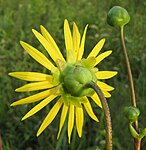- Balsamorhiza hookeri phyllaries are widely separated, hairy, stiff, and point away from the stem.
- These Silphium pinnatifidum phyllaries are graduated, with those closer to the flower longer than the outer layers.
Related Research Articles
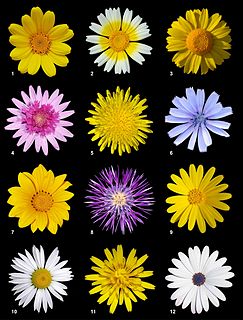
The family Asteraceae, alternatively Compositae, consists of over 32,000 known species of flowering plants in over 1,900 genera within the order Asterales. Commonly referred to as the aster, daisy, composite, or sunflower family, Compositae were first described in the year 1740. The number of species in Asteraceae is rivaled only by the Orchidaceae, and which is the larger family is unclear as the quantity of extant species in each family is unknown.
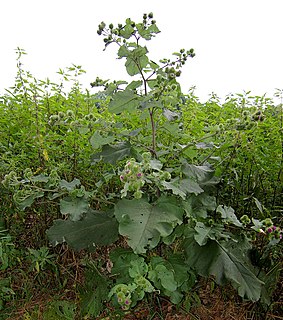
Arctium lappa, commonly called greater burdock, gobō (牛蒡/ゴボウ), edible burdock, lappa, beggar's buttons, thorny burr, or happy major is a Eurasian species of plants in the family Asteraceae, cultivated in gardens for its root used as a vegetable. It has become an invasive weed of high-nitrogen soils in North America, Australia, and other regions.

Eurybia is a genus of plants in the family Asteraceae that were previously included in the genus Aster. Most species are native to North America, although one is also present in northern Eurasia. There are 23 species in the genus, including 1 natural hybrid. The name was first applied by Alexandre de Cassini in 1820. The name is derived from Ancient Greek εὐρύς (eurús), meaning "wide", and βαιός (baiós), meaning "few", perhaps in reference to the small number of relatively wide ray florets.
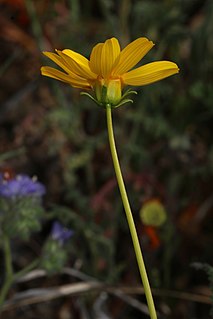
Coreopsis bigelovii is a species of flowering plant in the daisy or sunflower family, Asteraceae, with the common names Bigelow coreopsis and Bigelow's tickseed. It is endemic to California.

Grindelia stricta is a species of flowering plant in the family Asteraceae known by the common names Oregon gumplant, Oregon gumweed and coastal gumplant. It is native to the west coast of North America from California to Alaska, where it is a resident of coastal plant communities such as those in marshes and beaches. This plant is variable in appearance, taking the form of a weedlike perennial herb forming low clumps to a sprawling subshrub growing erect to heights exceeding one meter. Its foliage and stems are green to rusty red or purplish and the plant may be hairy to hairless. The fleshy leaves are green, often with red edges and veining, and are up to 15 centimeters in length on large plants. The inflorescence holds one or more flower heads each up to 5 centimeters wide. The flower head is a cup of thick erect or recurved green phyllaries. Yellow disc florets fill the center of the flower head and there is a fringe of yellow ray florets around the circumference. The head produces copious amounts of white latex, especially in the early stages of blooming.
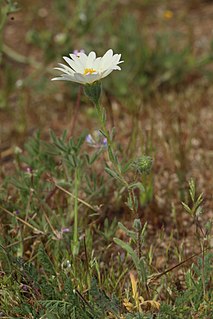
Layia glandulosa is a species of flowering plant in the family Asteraceae known by the common names whitedaisy tidytips and white layia. It is native to western North America south from central Washington (state) to Baja California and east to Utah and Arizona, where it is common in a number of habitat types.
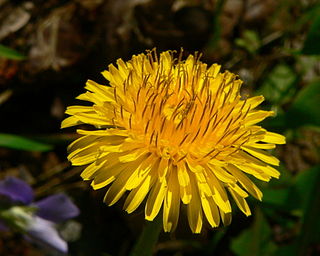
Taraxacum is a large genus of flowering plants in the family Asteraceae, which consists of species commonly known as dandelions. The scientific and hobby study of the genus is known as taraxacology. The genus is native to Eurasia and North America, but the two most commonplace species worldwide, T. officinale and T. erythrospermum, were introduced into North America from Europe and now propagate as wildflowers. Both species are edible in their entirety. The common name dandelion is also given to specific members of the genus.

Symphyotrichum ascendens is a species of flowering plant in the family Asteraceae known by the common names western aster, long-leaved aster, and Rocky Mountain aster. Blooming July–September, it is native to western North America and can be found at elevations of 500–3,200 m (1,600–10,500 ft) in several habitats.

Symphyotrichum greatae is a species of flowering plant in the family Asteraceae endemic to California and known by the common name Greata's aster.

Arctium tomentosum, commonly known as the woolly burdock or downy burdock, is a species of burdock belonging to the family Asteraceae. The species was described by Philip Miller in 1768.

Malacothrix californica is a species of flowering plant in the family Asteraceae known by the common name California desertdandelion. It is native to California, the western margin of Arizona and Baja California, where it may be found especially in the South Coast, Transverse and Peninsular Ranges and the western Mojave Desert.
Taraxacum pankhurstianum, also known as the St Kilda dandelion, is a species of dandelion that was identified as new in 2012 after being cultivated at the Royal Botanic Garden Edinburgh from seeds collected two years previously on the island of Hirta, the largest island in the St Kilda archipelago, on the western edge of Scotland.

Symphyotrichum dumosum is a species of flowering plant of the family Asteraceae commonly known as rice button aster and bushy aster. It is native to much of eastern and central North America, as well as Haiti and Dominican Republic. It is a perennial, herbaceous plant that may reach a height of 1 meter.

Hedypnois rhagadioloides, the Cretanweed or scaly hawkbit, is a species of plant in the tribe Cichorieae within the family Asteraceae. It is native to the Mediterranean Region and neighboring areas from Canary Islands to Iran, and naturalized in Australia and in parts of the Americas.

Felicia nordenstamii is a flowering shrub in the family Asteraceae. It is found only in South Africa where it grows on limestone hills close to the sea on the southern coast. Felicia nordenstamii is a many-branched shrub growing up to 30 cm (1 ft) tall. The lower parts of the stems are covered in grayish brown bark and the upper stem has many crowded, upwardly angled, alternate leaves with long hairs on the lower surfaces. Large flower heads form at the tips of the branches, each about 41⁄2 cm across, with about thirty purplish blue ray florets surrounding many yellow disc florets.
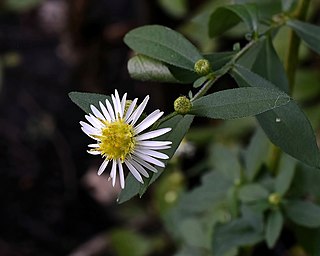
Symphyotrichum ontarionis is a species of flowering plant in the family Asteraceae native to eastern North America. Commonly known as Ontario aster and bottomland aster, it is a perennial, herbaceous plant that may reach 120 centimeters high. Each flower head has many tiny florets put together into what appear as one.

Symphyotrichum racemosum is a species of flowering plant native to parts of the United States and introduced in Canada. It is known as smooth white oldfield aster and small white aster. It is a perennial, herbaceous plant in the family Asteraceae. It is a late-summer and fall blooming flower.

Symphyotrichum molle is a species of flowering plant in the aster family (Asteraceae) endemic to the Bighorn Mountains of Montana and Wyoming in the United States. Commonly known as soft aster, it is a perennial, herbaceous plant that ranges from 30 to 60 centimeters in height.

Symphyotrichum pratense is a species of flowering plant in the family Asteraceae native to the southeastern United States. Commonly known as barrens silky aster, it is a perennial, herbaceous plant that may reach 40 to 60 centimeters tall. Its flowers have rose-purple ray florets and pink then purple disk florets.

Symphyotrichum chapmanii is a species of flowering plant in the family Asteraceae native to the Apalachicola River drainage basin of Alabama and Florida. Commonly known as savanna aster, it is a perennial, herbaceous plant that may reach 30 to 80 centimeters tall. Its flowers have purple to blue-lavender ray florets and pale yellow disk florets. It is a wetland species and is of conservation concern. It may be extirpated in Alabama.
References
- 1 2 "Jepson Herbarium: Jepson Flora Project: Jepson eFlora: Glossary". ucjeps.berkeley.edu. Retrieved 26 May 2019.
- ↑ "NYGB Steele Herbarium Glossary" . Retrieved May 23, 2019.
- 1 2 Reznicek, A.A.; Voss, E.G.; Walters, B.S. "Asteraceae". michiganflora.net. Michigan Flora. Retrieved 26 May 2019.
- 1 2 "Glossary of botanical terms for Compositae". www.kew.org. Retrieved 26 May 2019.
- ↑ Wu, Fu-Yu; Yahara, Tetsukazu (1 May 2017). "Recurved Taraxacum phyllaries function as a floral defense: experimental evidence and its implication for Taraxacum evolutionary history". Ecological Research. 32 (3): 313–329. doi:10.1007/s11284-017-1444-5. ISSN 1440-1703. S2CID 46343283.
- ↑ Hawthorn, Wayne R.; Hayne, P. D. (1 January 1978). "Seed production and predispersal seed predation in the biennial composite species, Arctium minus (Hill) Bernh. and A. lappa L.". Oecologia. 34 (3): 283–295. Bibcode:1978Oecol..34..283H. doi:10.1007/BF00344907. ISSN 1432-1939. PMID 28309875. S2CID 6102531.
- ↑ Clark, Patterson. "Burdock: Sowing seeds with fur and bur". The Washington Post. Retrieved 26 May 2019.


